Medication Safety: Analyzing Factors & Prevention Strategies
VerifiedAdded on 2023/05/27
|5
|1777
|351
Report
AI Summary
This report provides an analysis of medication errors, a significant issue in Australian hospitals, impacting patient outcomes and healthcare costs. It identifies key factors contributing to these errors, including nursing staff workload and skill mix, communication breakdowns among healthcare providers, and distractions during medication preparation and administration. The report emphasizes the importance of medication reconciliation, double-checking procedures, and proper documentation to mitigate errors. It concludes by advocating for evidence-based practice, continuous professional development, and patient empowerment to improve medication safety and enhance the quality of care, offering strategies for registered nurses to prevent medication errors in clinical practice. Desklib provides past papers and solved assignments for students.
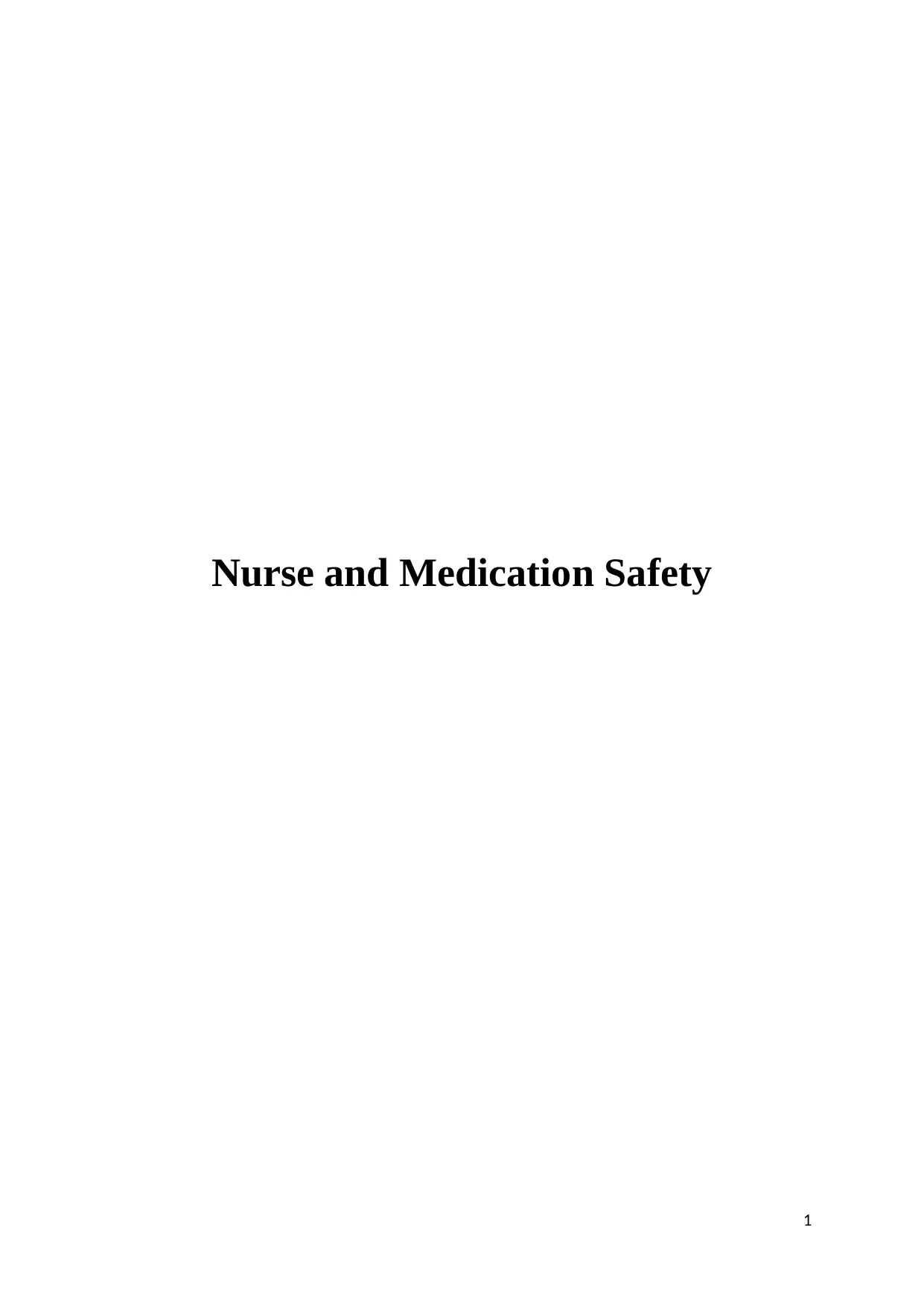
Nurse and Medication Safety
1
1
Paraphrase This Document
Need a fresh take? Get an instant paraphrase of this document with our AI Paraphraser
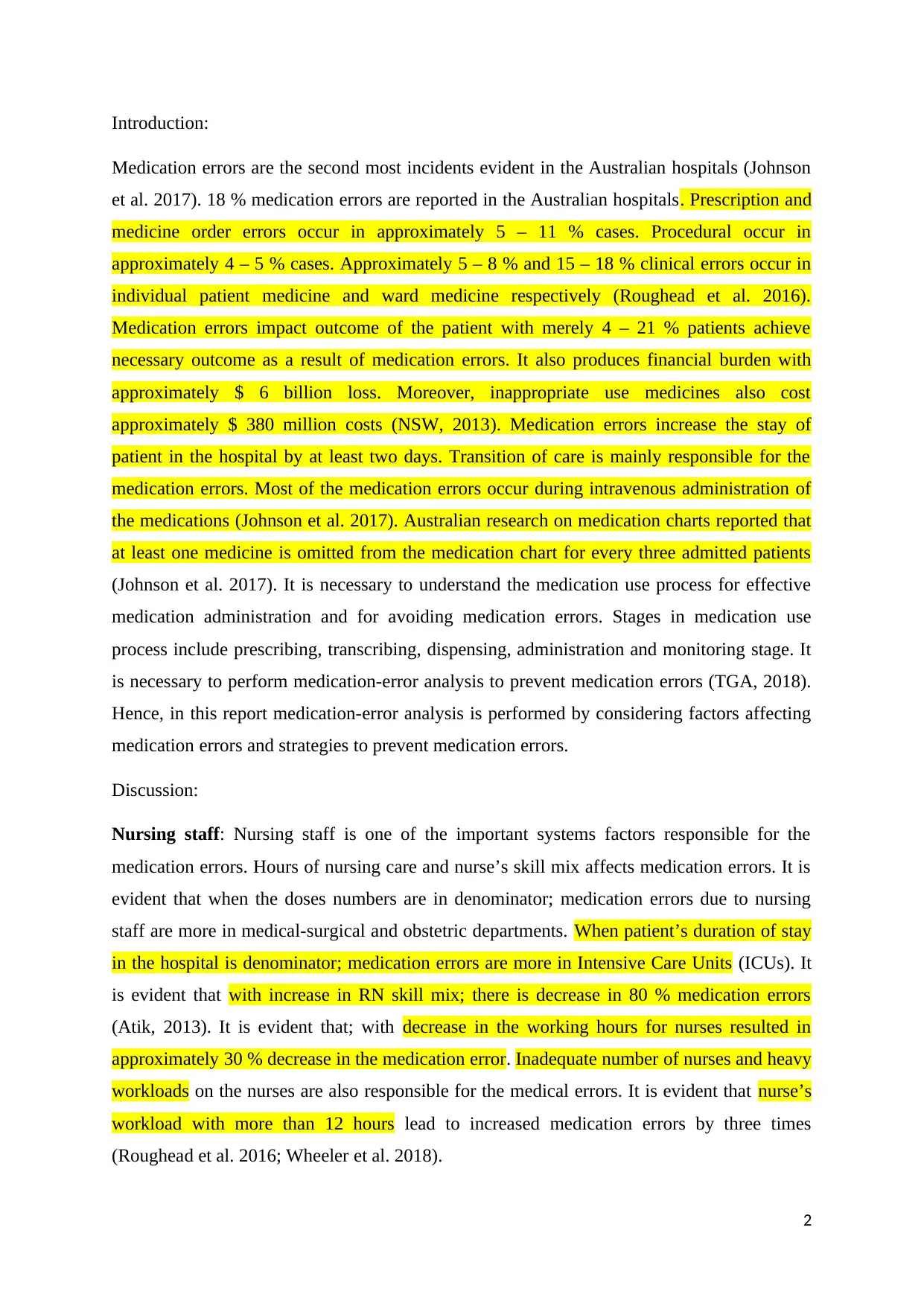
Introduction:
Medication errors are the second most incidents evident in the Australian hospitals (Johnson
et al. 2017). 18 % medication errors are reported in the Australian hospitals. Prescription and
medicine order errors occur in approximately 5 – 11 % cases. Procedural occur in
approximately 4 – 5 % cases. Approximately 5 – 8 % and 15 – 18 % clinical errors occur in
individual patient medicine and ward medicine respectively (Roughead et al. 2016).
Medication errors impact outcome of the patient with merely 4 – 21 % patients achieve
necessary outcome as a result of medication errors. It also produces financial burden with
approximately $ 6 billion loss. Moreover, inappropriate use medicines also cost
approximately $ 380 million costs (NSW, 2013). Medication errors increase the stay of
patient in the hospital by at least two days. Transition of care is mainly responsible for the
medication errors. Most of the medication errors occur during intravenous administration of
the medications (Johnson et al. 2017). Australian research on medication charts reported that
at least one medicine is omitted from the medication chart for every three admitted patients
(Johnson et al. 2017). It is necessary to understand the medication use process for effective
medication administration and for avoiding medication errors. Stages in medication use
process include prescribing, transcribing, dispensing, administration and monitoring stage. It
is necessary to perform medication-error analysis to prevent medication errors (TGA, 2018).
Hence, in this report medication-error analysis is performed by considering factors affecting
medication errors and strategies to prevent medication errors.
Discussion:
Nursing staff: Nursing staff is one of the important systems factors responsible for the
medication errors. Hours of nursing care and nurse’s skill mix affects medication errors. It is
evident that when the doses numbers are in denominator; medication errors due to nursing
staff are more in medical-surgical and obstetric departments. When patient’s duration of stay
in the hospital is denominator; medication errors are more in Intensive Care Units (ICUs). It
is evident that with increase in RN skill mix; there is decrease in 80 % medication errors
(Atik, 2013). It is evident that; with decrease in the working hours for nurses resulted in
approximately 30 % decrease in the medication error. Inadequate number of nurses and heavy
workloads on the nurses are also responsible for the medical errors. It is evident that nurse’s
workload with more than 12 hours lead to increased medication errors by three times
(Roughead et al. 2016; Wheeler et al. 2018).
2
Medication errors are the second most incidents evident in the Australian hospitals (Johnson
et al. 2017). 18 % medication errors are reported in the Australian hospitals. Prescription and
medicine order errors occur in approximately 5 – 11 % cases. Procedural occur in
approximately 4 – 5 % cases. Approximately 5 – 8 % and 15 – 18 % clinical errors occur in
individual patient medicine and ward medicine respectively (Roughead et al. 2016).
Medication errors impact outcome of the patient with merely 4 – 21 % patients achieve
necessary outcome as a result of medication errors. It also produces financial burden with
approximately $ 6 billion loss. Moreover, inappropriate use medicines also cost
approximately $ 380 million costs (NSW, 2013). Medication errors increase the stay of
patient in the hospital by at least two days. Transition of care is mainly responsible for the
medication errors. Most of the medication errors occur during intravenous administration of
the medications (Johnson et al. 2017). Australian research on medication charts reported that
at least one medicine is omitted from the medication chart for every three admitted patients
(Johnson et al. 2017). It is necessary to understand the medication use process for effective
medication administration and for avoiding medication errors. Stages in medication use
process include prescribing, transcribing, dispensing, administration and monitoring stage. It
is necessary to perform medication-error analysis to prevent medication errors (TGA, 2018).
Hence, in this report medication-error analysis is performed by considering factors affecting
medication errors and strategies to prevent medication errors.
Discussion:
Nursing staff: Nursing staff is one of the important systems factors responsible for the
medication errors. Hours of nursing care and nurse’s skill mix affects medication errors. It is
evident that when the doses numbers are in denominator; medication errors due to nursing
staff are more in medical-surgical and obstetric departments. When patient’s duration of stay
in the hospital is denominator; medication errors are more in Intensive Care Units (ICUs). It
is evident that with increase in RN skill mix; there is decrease in 80 % medication errors
(Atik, 2013). It is evident that; with decrease in the working hours for nurses resulted in
approximately 30 % decrease in the medication error. Inadequate number of nurses and heavy
workloads on the nurses are also responsible for the medical errors. It is evident that nurse’s
workload with more than 12 hours lead to increased medication errors by three times
(Roughead et al. 2016; Wheeler et al. 2018).
2
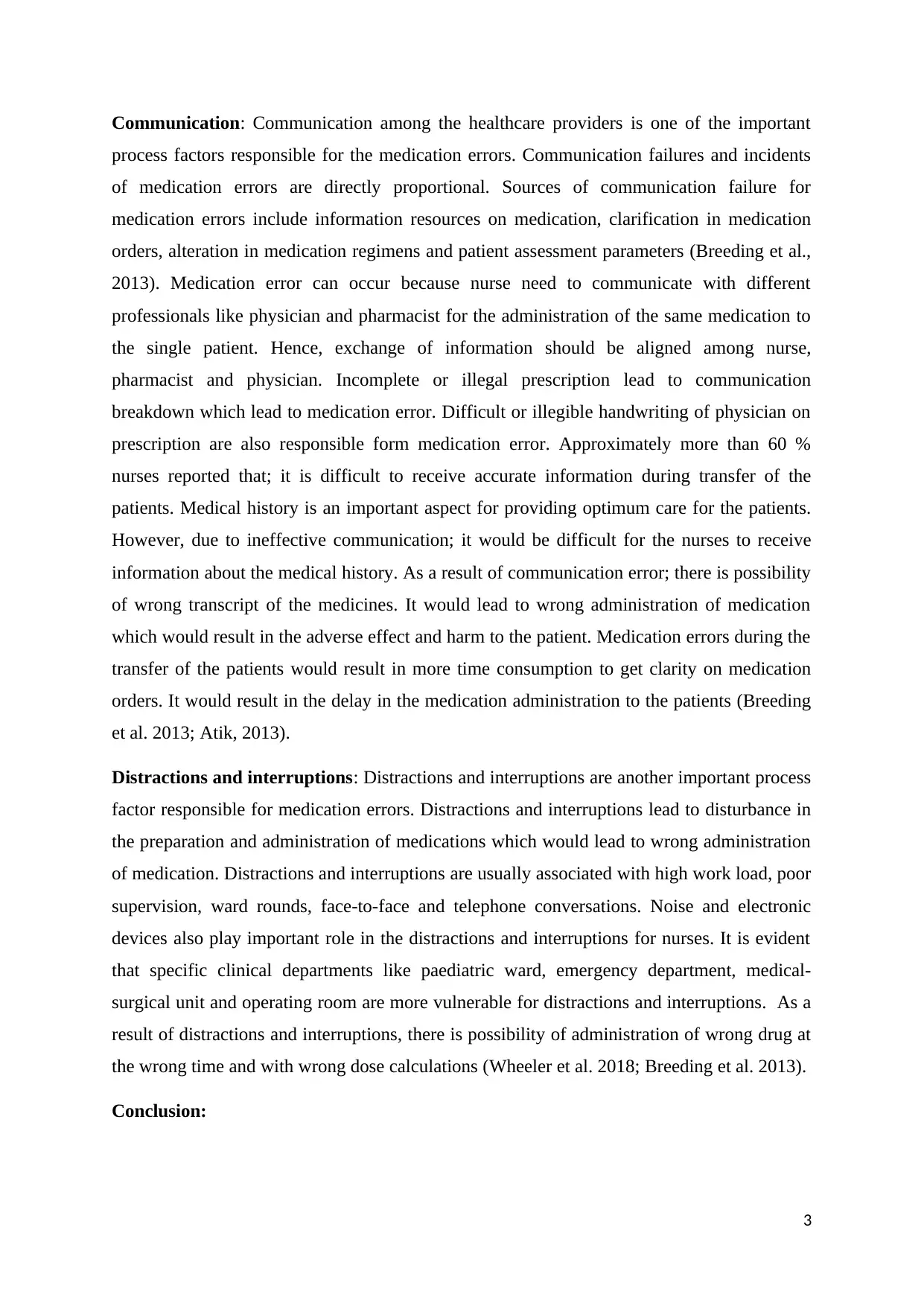
Communication: Communication among the healthcare providers is one of the important
process factors responsible for the medication errors. Communication failures and incidents
of medication errors are directly proportional. Sources of communication failure for
medication errors include information resources on medication, clarification in medication
orders, alteration in medication regimens and patient assessment parameters (Breeding et al.,
2013). Medication error can occur because nurse need to communicate with different
professionals like physician and pharmacist for the administration of the same medication to
the single patient. Hence, exchange of information should be aligned among nurse,
pharmacist and physician. Incomplete or illegal prescription lead to communication
breakdown which lead to medication error. Difficult or illegible handwriting of physician on
prescription are also responsible form medication error. Approximately more than 60 %
nurses reported that; it is difficult to receive accurate information during transfer of the
patients. Medical history is an important aspect for providing optimum care for the patients.
However, due to ineffective communication; it would be difficult for the nurses to receive
information about the medical history. As a result of communication error; there is possibility
of wrong transcript of the medicines. It would lead to wrong administration of medication
which would result in the adverse effect and harm to the patient. Medication errors during the
transfer of the patients would result in more time consumption to get clarity on medication
orders. It would result in the delay in the medication administration to the patients (Breeding
et al. 2013; Atik, 2013).
Distractions and interruptions: Distractions and interruptions are another important process
factor responsible for medication errors. Distractions and interruptions lead to disturbance in
the preparation and administration of medications which would lead to wrong administration
of medication. Distractions and interruptions are usually associated with high work load, poor
supervision, ward rounds, face-to-face and telephone conversations. Noise and electronic
devices also play important role in the distractions and interruptions for nurses. It is evident
that specific clinical departments like paediatric ward, emergency department, medical-
surgical unit and operating room are more vulnerable for distractions and interruptions. As a
result of distractions and interruptions, there is possibility of administration of wrong drug at
the wrong time and with wrong dose calculations (Wheeler et al. 2018; Breeding et al. 2013).
Conclusion:
3
process factors responsible for the medication errors. Communication failures and incidents
of medication errors are directly proportional. Sources of communication failure for
medication errors include information resources on medication, clarification in medication
orders, alteration in medication regimens and patient assessment parameters (Breeding et al.,
2013). Medication error can occur because nurse need to communicate with different
professionals like physician and pharmacist for the administration of the same medication to
the single patient. Hence, exchange of information should be aligned among nurse,
pharmacist and physician. Incomplete or illegal prescription lead to communication
breakdown which lead to medication error. Difficult or illegible handwriting of physician on
prescription are also responsible form medication error. Approximately more than 60 %
nurses reported that; it is difficult to receive accurate information during transfer of the
patients. Medical history is an important aspect for providing optimum care for the patients.
However, due to ineffective communication; it would be difficult for the nurses to receive
information about the medical history. As a result of communication error; there is possibility
of wrong transcript of the medicines. It would lead to wrong administration of medication
which would result in the adverse effect and harm to the patient. Medication errors during the
transfer of the patients would result in more time consumption to get clarity on medication
orders. It would result in the delay in the medication administration to the patients (Breeding
et al. 2013; Atik, 2013).
Distractions and interruptions: Distractions and interruptions are another important process
factor responsible for medication errors. Distractions and interruptions lead to disturbance in
the preparation and administration of medications which would lead to wrong administration
of medication. Distractions and interruptions are usually associated with high work load, poor
supervision, ward rounds, face-to-face and telephone conversations. Noise and electronic
devices also play important role in the distractions and interruptions for nurses. It is evident
that specific clinical departments like paediatric ward, emergency department, medical-
surgical unit and operating room are more vulnerable for distractions and interruptions. As a
result of distractions and interruptions, there is possibility of administration of wrong drug at
the wrong time and with wrong dose calculations (Wheeler et al. 2018; Breeding et al. 2013).
Conclusion:
3
⊘ This is a preview!⊘
Do you want full access?
Subscribe today to unlock all pages.

Trusted by 1+ million students worldwide
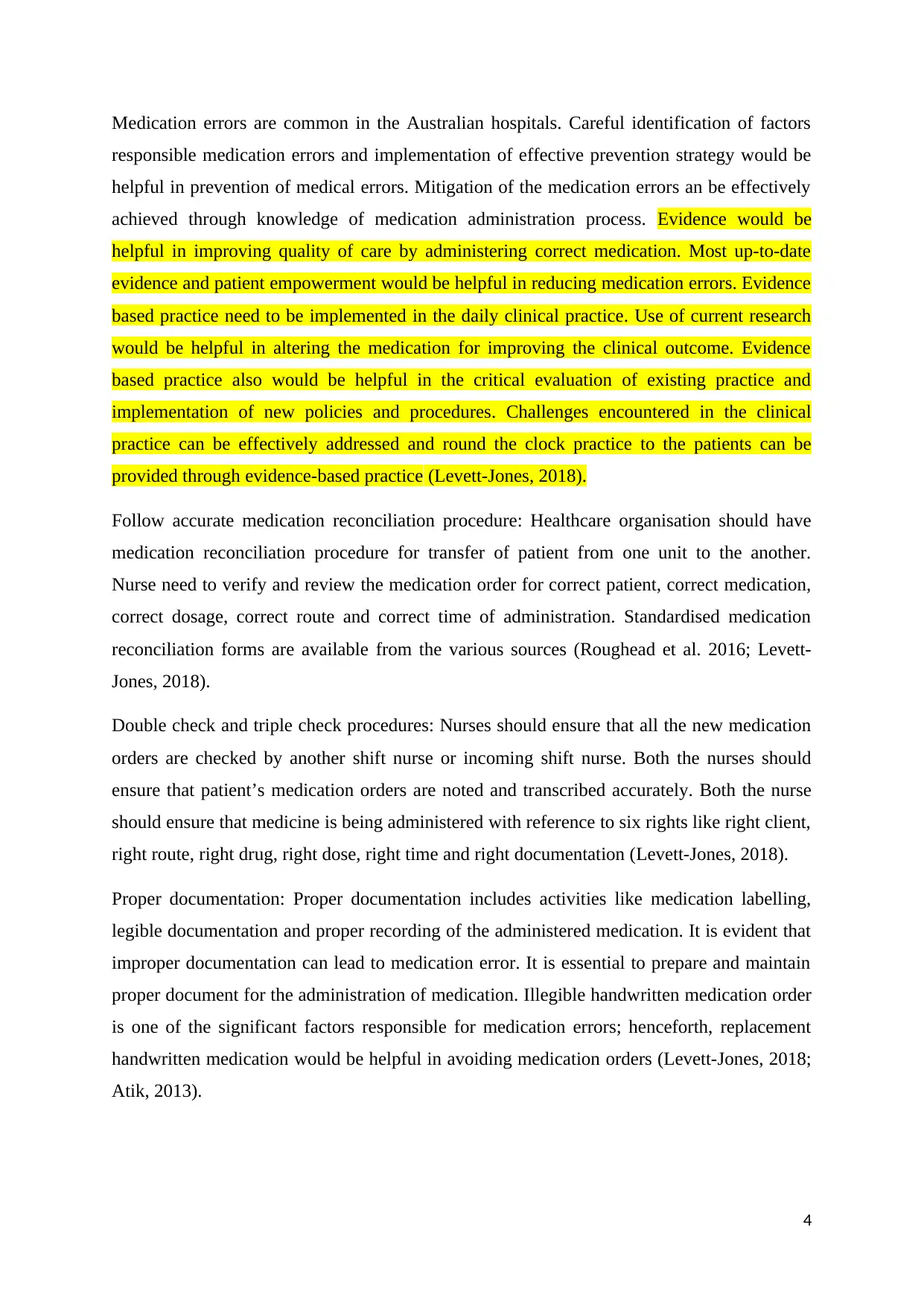
Medication errors are common in the Australian hospitals. Careful identification of factors
responsible medication errors and implementation of effective prevention strategy would be
helpful in prevention of medical errors. Mitigation of the medication errors an be effectively
achieved through knowledge of medication administration process. Evidence would be
helpful in improving quality of care by administering correct medication. Most up-to-date
evidence and patient empowerment would be helpful in reducing medication errors. Evidence
based practice need to be implemented in the daily clinical practice. Use of current research
would be helpful in altering the medication for improving the clinical outcome. Evidence
based practice also would be helpful in the critical evaluation of existing practice and
implementation of new policies and procedures. Challenges encountered in the clinical
practice can be effectively addressed and round the clock practice to the patients can be
provided through evidence-based practice (Levett-Jones, 2018).
Follow accurate medication reconciliation procedure: Healthcare organisation should have
medication reconciliation procedure for transfer of patient from one unit to the another.
Nurse need to verify and review the medication order for correct patient, correct medication,
correct dosage, correct route and correct time of administration. Standardised medication
reconciliation forms are available from the various sources (Roughead et al. 2016; Levett-
Jones, 2018).
Double check and triple check procedures: Nurses should ensure that all the new medication
orders are checked by another shift nurse or incoming shift nurse. Both the nurses should
ensure that patient’s medication orders are noted and transcribed accurately. Both the nurse
should ensure that medicine is being administered with reference to six rights like right client,
right route, right drug, right dose, right time and right documentation (Levett-Jones, 2018).
Proper documentation: Proper documentation includes activities like medication labelling,
legible documentation and proper recording of the administered medication. It is evident that
improper documentation can lead to medication error. It is essential to prepare and maintain
proper document for the administration of medication. Illegible handwritten medication order
is one of the significant factors responsible for medication errors; henceforth, replacement
handwritten medication would be helpful in avoiding medication orders (Levett-Jones, 2018;
Atik, 2013).
4
responsible medication errors and implementation of effective prevention strategy would be
helpful in prevention of medical errors. Mitigation of the medication errors an be effectively
achieved through knowledge of medication administration process. Evidence would be
helpful in improving quality of care by administering correct medication. Most up-to-date
evidence and patient empowerment would be helpful in reducing medication errors. Evidence
based practice need to be implemented in the daily clinical practice. Use of current research
would be helpful in altering the medication for improving the clinical outcome. Evidence
based practice also would be helpful in the critical evaluation of existing practice and
implementation of new policies and procedures. Challenges encountered in the clinical
practice can be effectively addressed and round the clock practice to the patients can be
provided through evidence-based practice (Levett-Jones, 2018).
Follow accurate medication reconciliation procedure: Healthcare organisation should have
medication reconciliation procedure for transfer of patient from one unit to the another.
Nurse need to verify and review the medication order for correct patient, correct medication,
correct dosage, correct route and correct time of administration. Standardised medication
reconciliation forms are available from the various sources (Roughead et al. 2016; Levett-
Jones, 2018).
Double check and triple check procedures: Nurses should ensure that all the new medication
orders are checked by another shift nurse or incoming shift nurse. Both the nurses should
ensure that patient’s medication orders are noted and transcribed accurately. Both the nurse
should ensure that medicine is being administered with reference to six rights like right client,
right route, right drug, right dose, right time and right documentation (Levett-Jones, 2018).
Proper documentation: Proper documentation includes activities like medication labelling,
legible documentation and proper recording of the administered medication. It is evident that
improper documentation can lead to medication error. It is essential to prepare and maintain
proper document for the administration of medication. Illegible handwritten medication order
is one of the significant factors responsible for medication errors; henceforth, replacement
handwritten medication would be helpful in avoiding medication orders (Levett-Jones, 2018;
Atik, 2013).
4
Paraphrase This Document
Need a fresh take? Get an instant paraphrase of this document with our AI Paraphraser
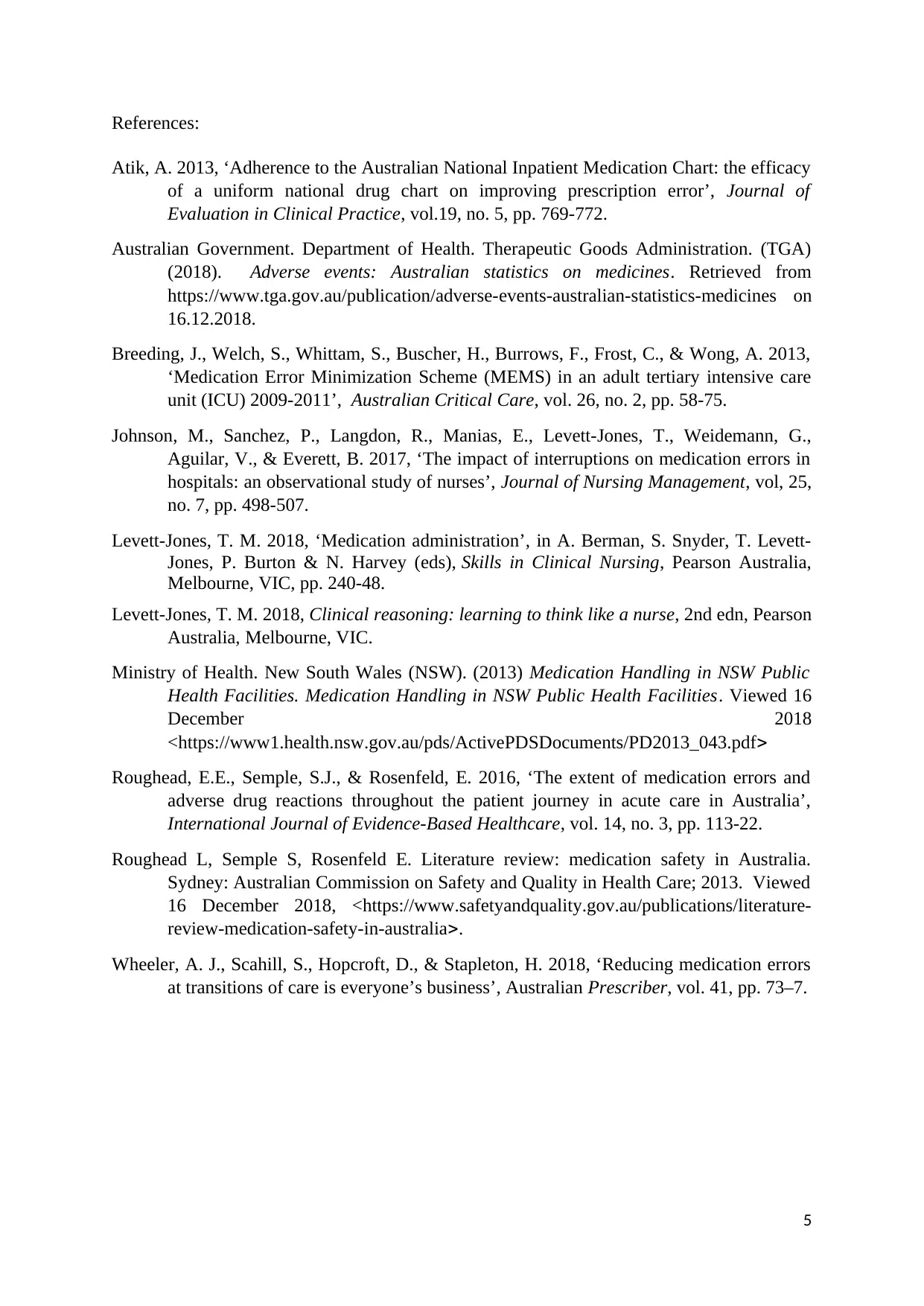
References:
Atik, A. 2013, ‘Adherence to the Australian National Inpatient Medication Chart: the efficacy
of a uniform national drug chart on improving prescription error’, Journal of
Evaluation in Clinical Practice, vol.19, no. 5, pp. 769-772.
Australian Government. Department of Health. Therapeutic Goods Administration. (TGA)
(2018). Adverse events: Australian statistics on medicines. Retrieved from
https://www.tga.gov.au/publication/adverse-events-australian-statistics-medicines on
16.12.2018.
Breeding, J., Welch, S., Whittam, S., Buscher, H., Burrows, F., Frost, C., & Wong, A. 2013,
‘Medication Error Minimization Scheme (MEMS) in an adult tertiary intensive care
unit (ICU) 2009-2011’, Australian Critical Care, vol. 26, no. 2, pp. 58-75.
Johnson, M., Sanchez, P., Langdon, R., Manias, E., Levett-Jones, T., Weidemann, G.,
Aguilar, V., & Everett, B. 2017, ‘The impact of interruptions on medication errors in
hospitals: an observational study of nurses’, Journal of Nursing Management, vol, 25,
no. 7, pp. 498-507.
Levett-Jones, T. M. 2018, ‘Medication administration’, in A. Berman, S. Snyder, T. Levett-
Jones, P. Burton & N. Harvey (eds), Skills in Clinical Nursing, Pearson Australia,
Melbourne, VIC, pp. 240-48.
Levett-Jones, T. M. 2018, Clinical reasoning: learning to think like a nurse, 2nd edn, Pearson
Australia, Melbourne, VIC.
Ministry of Health. New South Wales (NSW). (2013) Medication Handling in NSW Public
Health Facilities. Medication Handling in NSW Public Health Facilities. Viewed 16
December 2018
˂https://www1.health.nsw.gov.au/pds/ActivePDSDocuments/PD2013_043.pdf
Roughead, E.E., Semple, S.J., & Rosenfeld, E. 2016, ‘The extent of medication errors and
adverse drug reactions throughout the patient journey in acute care in Australia’,
International Journal of Evidence-Based Healthcare, vol. 14, no. 3, pp. 113-22.
Roughead L, Semple S, Rosenfeld E. Literature review: medication safety in Australia.
Sydney: Australian Commission on Safety and Quality in Health Care; 2013. Viewed
16 December 2018, ˂https://www.safetyandquality.gov.au/publications/literature-
review-medication-safety-in-australia.
Wheeler, A. J., Scahill, S., Hopcroft, D., & Stapleton, H. 2018, ‘Reducing medication errors
at transitions of care is everyone’s business’, Australian Prescriber, vol. 41, pp. 73–7.
5
Atik, A. 2013, ‘Adherence to the Australian National Inpatient Medication Chart: the efficacy
of a uniform national drug chart on improving prescription error’, Journal of
Evaluation in Clinical Practice, vol.19, no. 5, pp. 769-772.
Australian Government. Department of Health. Therapeutic Goods Administration. (TGA)
(2018). Adverse events: Australian statistics on medicines. Retrieved from
https://www.tga.gov.au/publication/adverse-events-australian-statistics-medicines on
16.12.2018.
Breeding, J., Welch, S., Whittam, S., Buscher, H., Burrows, F., Frost, C., & Wong, A. 2013,
‘Medication Error Minimization Scheme (MEMS) in an adult tertiary intensive care
unit (ICU) 2009-2011’, Australian Critical Care, vol. 26, no. 2, pp. 58-75.
Johnson, M., Sanchez, P., Langdon, R., Manias, E., Levett-Jones, T., Weidemann, G.,
Aguilar, V., & Everett, B. 2017, ‘The impact of interruptions on medication errors in
hospitals: an observational study of nurses’, Journal of Nursing Management, vol, 25,
no. 7, pp. 498-507.
Levett-Jones, T. M. 2018, ‘Medication administration’, in A. Berman, S. Snyder, T. Levett-
Jones, P. Burton & N. Harvey (eds), Skills in Clinical Nursing, Pearson Australia,
Melbourne, VIC, pp. 240-48.
Levett-Jones, T. M. 2018, Clinical reasoning: learning to think like a nurse, 2nd edn, Pearson
Australia, Melbourne, VIC.
Ministry of Health. New South Wales (NSW). (2013) Medication Handling in NSW Public
Health Facilities. Medication Handling in NSW Public Health Facilities. Viewed 16
December 2018
˂https://www1.health.nsw.gov.au/pds/ActivePDSDocuments/PD2013_043.pdf
Roughead, E.E., Semple, S.J., & Rosenfeld, E. 2016, ‘The extent of medication errors and
adverse drug reactions throughout the patient journey in acute care in Australia’,
International Journal of Evidence-Based Healthcare, vol. 14, no. 3, pp. 113-22.
Roughead L, Semple S, Rosenfeld E. Literature review: medication safety in Australia.
Sydney: Australian Commission on Safety and Quality in Health Care; 2013. Viewed
16 December 2018, ˂https://www.safetyandquality.gov.au/publications/literature-
review-medication-safety-in-australia.
Wheeler, A. J., Scahill, S., Hopcroft, D., & Stapleton, H. 2018, ‘Reducing medication errors
at transitions of care is everyone’s business’, Australian Prescriber, vol. 41, pp. 73–7.
5
1 out of 5
Related Documents
Your All-in-One AI-Powered Toolkit for Academic Success.
+13062052269
info@desklib.com
Available 24*7 on WhatsApp / Email
![[object Object]](/_next/static/media/star-bottom.7253800d.svg)
Unlock your academic potential
Copyright © 2020–2025 A2Z Services. All Rights Reserved. Developed and managed by ZUCOL.





